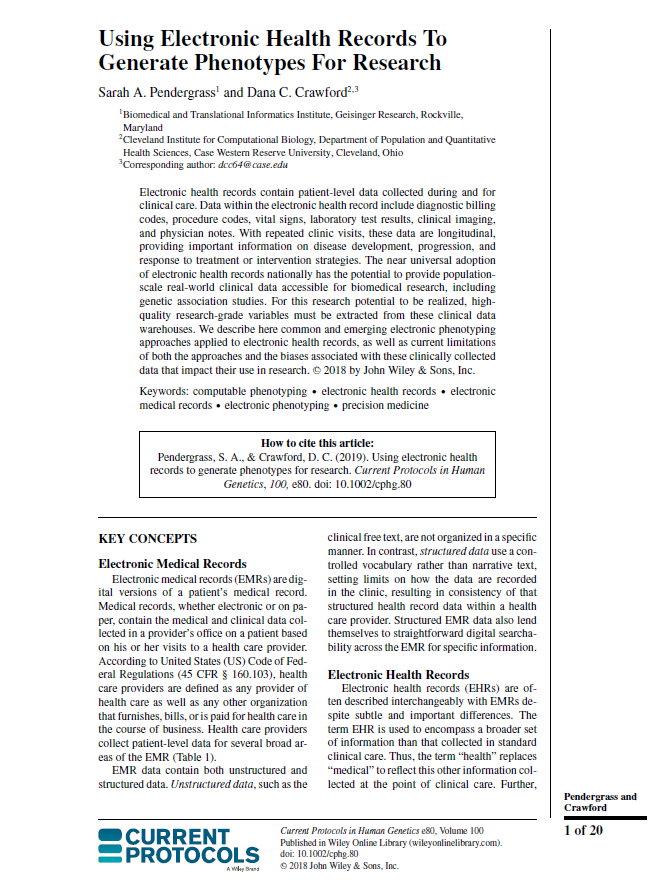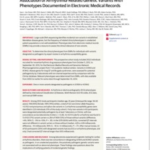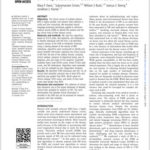Sarah A. Pendergrass and Dana C. Crawford Electronic health records contain patient-level data collected during and for clinical care. Data within the electronic health record include diagnostic billing codes, procedure codes, vital signs, laboratory test results, clinical imaging, and physician notes. With repeated clinic visits, these data are longitudinal, providing important information on disease development, […]
Tag Archives: Electronic Health Records
Association of Arrhythmia-Related Genetic Variants With Phenotypes Documented in Electronic Medical Records.
Large-scale DNA sequencing identifies incidental rare variants in established Mendelian disease genes, but the frequency of related clinical phenotypes in unselected patient populations is not well established. Phenotype data from electronic medical records (EMRs) may provide a resource to assess the clinical relevance of rare variants.To determine the clinical phenotypes from EMRs for individuals with […]
Association of Arrhythmia-Related Genetic Variants With Phenotypes Documented in Electronic Medical Records.
Van Driest SL, Wells QS, Stallings S, Bush WS, Gordon A, Nickerson DA, Kim JH, Crosslin DR, Jarvik GP, Carrell DS, Ralston JD, Larson EB, Bielinski SJ, Olson JE, Ye Z, Kullo IJ, Abul-Husn NS, Scott SA, Bottinger E, Almoguera B, Connolly J, Chiavacci R, Hakonarson H, Rasmussen-Torvik LJ, Pan V, Persell SD, Smith M, […]
Automated extraction of clinical traits of multiple sclerosis in electronic medical records.
The clinical course of multiple sclerosis (MS) is highly variable, and research data collection is costly and time consuming. We evaluated natural language processing techniques applied to electronic medical records (EMR) to identify MS patients and the key clinical traits of their disease course.We used four algorithms based on ICD-9 codes, text keywords, and medications […]
Automated extraction of clinical traits of multiple sclerosis in electronic medical records.
Davis MF, Sriram S, Bush WS, Denny JC, Haines JL,. The clinical course of multiple sclerosis (MS) is highly variable, and research data collection is costly and time consuming. We evaluated natural language processing techniques applied to electronic medical records (EMR) to identify MS patients and the key clinical traits of their disease course.We used […]
Utilization of an EMR-biorepository to identify the genetic predictors of calcineurin-inhibitor toxicity in heart transplant recipients.
Calcineurin-inhibitors CI are immunosuppressive agents prescribed to patients after solid organ transplant to prevent rejection. Although these drugs have been transformative for allograft survival, long-term use is complicated by side effects including nephrotoxicity. Given the narrow therapeutic index of CI, therapeutic drug monitoring is used to prevent acute rejection from underdosing and acute toxicity from […]
Utilization of an EMR-biorepository to identify the genetic predictors of calcineurin-inhibitor toxicity in heart transplant recipients.
Oetjens M, Bush WS, Birdwell KA, Dilks HH, Bowton EA, Denny JC, Wilke RA, Roden DM, Crawford DC,. Calcineurin-inhibitors CI are immunosuppressive agents prescribed to patients after solid organ transplant to prevent rejection. Although these drugs have been transformative for allograft survival, long-term use is complicated by side effects including nephrotoxicity. Given the narrow therapeutic […]







